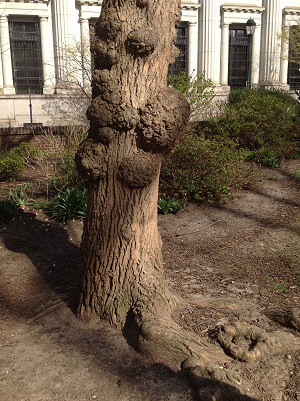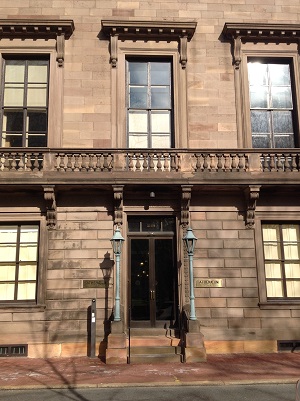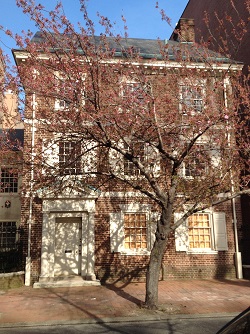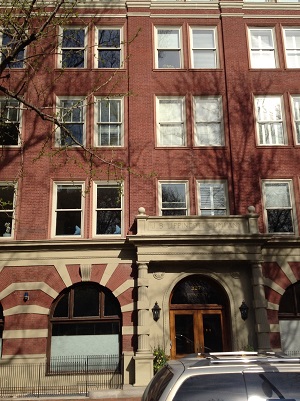Washington Square
Page 2
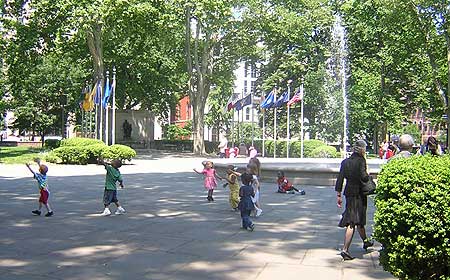
A Tour of the Park
Start in the southwest corner and move clockwise...
We'll start our tour at 230 West Washington Square, where a cornucopia sculpted in stone overhangs a door. Abounding with grapes, corn, and various comestibles, the horn of plenty provides a tasty welcome to the Farm Journal Building. The Farm Journal began ingraining farmers with knowledge in 1827 from a site not far distant from its present locale. The magazine's initial readership consisted of "farmers living within a day's buggy ride" of Philadelphia. Today it is the largest farming magazine in the country, with specialized additions produced to meet particular regional needs. Readers can glean knowledge from scientific articles or just admire the gleam from attractive tractors pictured within.
The Farm Journal Building was built in 1911. Like many addresses in historic Philadelphia, this structure has been built on the site of a fondly remembered building, in this case the Orange Street Friends' Meeting House. Now Orange Street and that Friends Meeting House exist only in the palimpsest that is historic Philadelphia. If we peel away a layer of history, Morley's delicious Orange Street consisting of "delightful clusters of back gardens, odd brick angles, dormer windows and tall chimneys" comes to nourish us. He goes on, "Orange Street is the little alley just south of Washington Square. In the clean sunlight of a fresh May morning, with masses of green trees and creepers to set off the old ruddy brick, this quaint huddle of buildings composes into a delightful picture."
Midway through the block, on the corner of 7th and Locust Streets is the former headquarters of the venerable W.B. Saunders Publishing Company which dates back to 1888. The Company has since relocated to the Curtis Building, which we'll visit on the north side of Washington Square. Though Saunders has long been a leader in the field of medical publishing, perhaps its best-known work may be the landmark Kinsey Report of 1948.
Continue north and reach the building which once housed the oldest advertising company in the United States, N.W. Ayer & Son, founded in 1869. The building, a paean to advertising and the Age of Art Deco, was built in 1928 by Ralph Bencker. Pairs of giant deco sculptures seem to grow out of each side of the top of the 15-story building. The bronze doors of the building's entrance facing Washington Square are no less marvelous. Figures carved into panels in the door depict advertising employees at work while all about them signs of the zodiac are presumably influencing them. Curiously, the figures are all dressed in Pharaoh-like robes while doing their office work. Perhaps they posed on a dress-down Friday. Ayer, once Philadelphia's largest advertising company, relocated to New York City in 1973 and is known today as N.W. Ayer ABH International.
We've Reached the Northwest Corner...
An Italianate bank graces the northwest corner. It was the headquarters of The Philadelphia Savings Fund Society (PSFS), a benevolent institution founded in 1816 without stockholders. In 1868, PSFS held a design competition to build this building, their second headquarters, which was won by the firm of Sloan and Hutton. Addison Hutton designed the bank which was completed in 1869 and expanded by the same architect in 1885-86.
Today, when ATMs are the only things distinguishing most new bank buildings from doughnut joints, it's a travesty that the PSFS building sits unoccupied. Our merger-mad times do not allow for substantial buildings of this type. Replete with ornate wrought-iron balconies on the inside, and a distinguished balustrade overlooking granite ashlar on the outside — it's a far cry from the typical bank we make deposits in today. Walking into this building would have been a dignified, meaningful experience.
At 701 Walnut Street is the Bible House. This is home to the Pennsylvania Bible Society, the oldest such group in the country. The Society, formed in 1808, has distributed Bibles in 73 different languages.
Dreamy Dreams
Anchoring the north side of Washington Square is the Curtis Center, home to Curtis Publishing (a stop along our "virtual" tour). From these offices came The Saturday Evening Post, The Ladies Home Journal, and Jack and Jill. Here too, was an organization with a love for the arts. Not only is the Beaux Arts building, designed by Edgar Seeler in 1910, a natural extension of the Square on the outside, but the inside contains a Tiffany studios glass-mosaic recreation of Maxfield Parrish's The Dream Garden. Here in the midst of the chaotic world of publishing is Parrish's serene, time-out-of-mind, garden scene. The mosaic consists of over 100,000 pieces of hand-fired glass in 260 color tones which measures 15 feet high by 49 feet wide. All are encouraged to visit the dreamy dream artwork. The Center's atrium also contains one of the finest fountain-waterfalls in the city. A terraced waterfall languidly licks its way down obsidian slopes from the atrium's third floor to the ground level. The atrium itself is filled with faux Egyptian palms — indeed the fountain would not seem out of place at the court of Ramses II.
We've Reached the Northeast Corner...
At the corner of 6th and Walnut Streets, on the Square's eastern side, is an office building belonging to the Penn Mutual Insurance Company. In 1913, Edgar Seeler, architect of the Curtis Center, also designed this structure. The adjacent skyscraper also belonging to Penn Mutual is of interest. The facade of John Haviland's 1838 Egyptian Revival design for the Pennsylvania Fire Insurance Co. was retained intact and serves as a faux facade for the skyscraper.
Go to Jail
Penn Mutual was built on the site of Robert Smith's historic Walnut Street Jail which stood from 1775 to 1838. This prison was the site of the earliest experiments in criminal rehabilitation in the United States. After serving as a brutal military prison for both sides in the Revolutionary War, it underwent change in 1790 when the Pennsylvania Assembly passed a series of prison reform bills. New prison practice included segregation of the sexes, separation of juveniles from adults, and the creation of distinct prisons for debtors and felons.
George Washington spent a good amount of time in the debtor's prison — visiting his good friend Robert Morris, the financier of the Revolution. Morris had fallen on hard times, in part due to his attempt at building a personal Xanadu on High (Market) Street which bankrupted him. Not even Washington's friendship could keep Morris from jail. Prisoners in the debtor's prison were allowed to bring with them any possessions they still owned. However, they remained in limbo being as their sentences were of indeterminant length. Release came only after the scofflaw's finances took a turn for the better or someone on the outside provided capital.
Prisoners in the Walnut Street Jail worked off the cost of their incarceration in prison workshops where they produced goods which were then sold. The prisoner was given a moiety of whatever the product sold for less the cost of his incarceration. Court and attorneys' fees were also deducted from what a prisoner earned. Artisans trained prisoners in rewarding crafts, and as a result recidivism dropped sharply.
It Is Balloon
The prison yard was the site of a soaring success in 1793, as excerpted from The Romance of Old Philadelphia, by John T. Faris, published by J.P. Lippincott in 1918: "The yard of the gaol was the scene of one of the spectacular incidents of the period of Washington's residence in Philadelphia. On January 9, 1793, the French aeronaut Blanchard made there the first balloon ascension in America. Washington and all the leading men of the city were interested, most of them having contributed to the expense of preparing the balloon. Just before the ascent, the President handed to the aeronaut a passport which could be shown to anyone who, being unfamiliar with a balloon, might offer to do the man harm. The document authorized him to pass in such direction and to descend in such a place as circumstance may render the most convenient. The balloon rose majestically, floated across the Delaware, and came down near Gloucester [New Jersey]. Jonathan Penrose, Robert Wharton, and a number of other Philadelphians followed on their horses and brought the aeronaut in triumph back to the city."
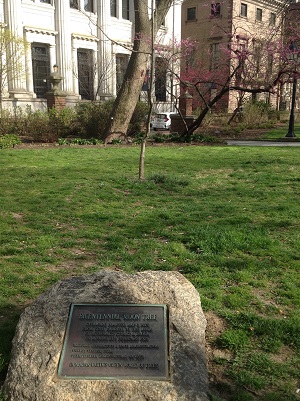
The historical marker positioned directly in front seems to imply that this is the moon tree, but it seems too young and does not appear to be a sycamore.
In the park grows a sycamore tree with seeds planted on May 6, 1975. The seeds were carried to the moon by astronaut Stuart Roosa on Apollo XIV. "The bicentennial moon tree" grows less than a hundred yards from where the first space flight in America occurred.
Moving southward to 219 S. 6th Street we come to the Athenaeum. An Athenaeum is an institution or society for the promotion of literary or scientific learning. Several Athenaeums were built in the early part of the 19th century and Athenaeums served as private libraries for the well-healed. The Philadelphia Athenaeum, the first Italianate building in America, was built in 1845 by the architect John Notman. The likes of Dickens, Garibaldi, and Edgar Allan Poe all visited what is arguably Philadelphia's finest reading room.
Look closely at the house hugged between the Athenaeum and Lippincott Publishing. This Colonial Revival mansion was built by Mayor Richardson Dilworth and his wife Ann in 1957. It was designed by the prominent architect G. Edwin Brumbaugh, who also restored Washington Square in the mid-1950's. The mansion was built to show the first family's commitment to the revitalization of Society Hill, then a run-down part of the city. It proved an inspiration to other "pioneers" who followed into the community.
We come next to the headquarters of J.B. Lippincott located in an Italianate building at 227-31 S. 6th Street. This singular building dates back to 1900 and was designed by architect William B. Pritchett. Beginning business the year Washington first took office, Lippincott has long been an eminent publisher in the medical, literary, and Philadelphia historical fields. In addition to publishing works by stellar local authors like John T. Faris (quoted above) and Horace Mather Lippincott, the firm has also published pieces by Oscar Wilde, Sir Arthur Conan Doyle, Washington Irving, and Edgar Allan Poe. In the 1970s, Lippincott merged with Harper & Row.
We've Reached the Southeast Corner...
Lea & Febiger, at the corner of 6th and Locust, was once the home of the oldest still-active (though at a different location) publisher in the United States. Established by Mathew Carey in 1785, and partly financed by a $400 loan from Lafayette (which was paid back when Lafayette was in dire financial straits), it is the oldest book publishing business in the country. If you look at your copy of Gray's Anatomy, chances are it was published by Lea & Febiger.
The apartment building which dominates the southern side of the Square was built over the site of the First Presbyterian Church [through the congregation of this church and the Philadelphia Presbytery and Synod came the foundation of Princeton University].
We end our stroll around the park at Christopher Morley's old home, which is situated three houses from the southwest corner. Morley lived in the house before he achieved his biggest success with "Kitty Foyle," a fine book which when made into a movie garnered Ginger Rogers her sole Academy Award. The inn was once the center of a genteel art colony whose studios were scattered in the vicinity of Washington Square.
We leave the square with the words of Christopher Morley, the minstrel of meandering, who mused, "And as one walks and speculates among all this visible panorama, beating one's brains to catch some passing snapshots of it, watching, listening, imagining, the whole hullabaloo becomes extraordinarily precious. The Great faulty hodge-podge of the city, its very pavements and housecorners, becomes vividly dear."
- It was in the air over Washington Square that Americans first witnessed flight. Aeronaut Jean Pierre Blanchard made the first balloon ascension in America from the Walnut Street Jail in 1793.
- A wall of law books in the lobby of the Bisel Building at 710 Washington Square was used as a backdrop in one of the ) Rocky films.
- Bisel, a company serving the legal profession, once had its facade filmed for a mini-series on George Washington. The editors of the TV film forgot to cut out the air conditioners hanging from the windows.
- The Farm Journal is still the largest farm publication in the United States.
- The Philadelphia Savings Fund Society (PSFS — still nominally in existence as Mellon-PSFS) was founded in 1816 as a benevolent institution without stockholders.
- The Athenaeum is a National Historic Landmark.
- 245 S. Sixth was once the residence of General Count Groucy, one of Napoleon's 26 marshals. He had to flee France after his no-show at Waterloo. Popular sentiment against him in France forced him to his personal Elba — Philadelphia.
- Location: Bounded by 6th and 7th Streets and Walnut and South Seventh Street (Map)
- Tourism information: Park is open to the public. Plenty of benches.


